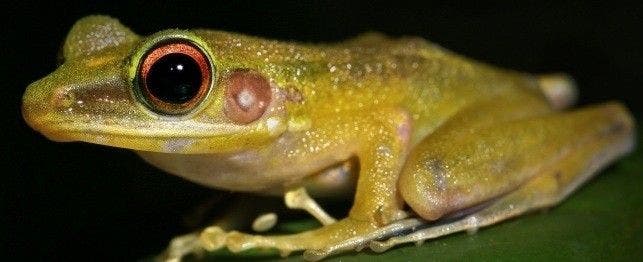
Choosing a White-Lipped Treefrog
The white-lipped treefrog Litoria infrafrenata is a very large Indonesian treefrog quite popular in the pet trade. Like all amphibians, these large treefrogs produce glandular skin secretions that are probably at least twofold in function – to deter predators and to keep the skin moist. White-lipped treefrogs range widely through New Guinea, but are also known in Australia and have been introduced to Java. They are adapted to life in tropical river areas.
With proper care and housing, white-lipped treefrogs are quite easy to keep but are considered a species for moderately advanced hobbyists. The record reported captive life span for this pretty treefrog is just in excess of 7 years, but as husbandry knowledge increases, life spans of more than 10 years are probably attainable.
Appearance
White-lipped treefrogs may be brown or green and have a rounded snout and white lips. They are heavy-bodied frogs with a slightly granular (roughened) skin. A white side stripe is usually present. Females may attain a full 4 inches in body length, and are typically slightly more heavy-bodied than the males. The prominent toepads of these arboreal frogs allow them to climb agilely.
Behavior
Despite their large size, white-lipped treefrogs are secretive. Their coloration and form allow them to be easily overlooked. These frogs are from moist habitats, thus, as captives, they require a similarly moist habitat. The preferred temperature range for the terrarium is a humid 78 to 85 degrees Fahrenheit.
These frogs generally do well communally. Males may wrestle with each other to assert dominance and they voice their harsh, repeated calls while sitting on large limbs or on the ground.
White-lipped treefrogs are primarily nocturnal, but may be active on cloudy days during the passage of low-pressure systems.
To prevent impurities from being absorbed through the skin, terrarium freshness is mandatory.
Feeding
The diet of the white-lipped treefrog should consist of a wide variety of gut-loaded insects. Crickets, roaches, earthworms, waxworms, trevo-worms and super mealworms, will all be accepted. Additionally, non-noxious insects such as June beetles and grubs, collected from your yard (providing you don’t use insecticides) are excellent treats. Dust the insects with vitamin-mineral supplements at least once weekly. A very occasional pinky mouse may be offered to add variety. Because of the unnaturally high fat content of lab mice no more than one every week or two should be given.
Insufficient vitamin D3 can result in improper calcium metabolism but an overabundance of D3 can result in an over-metabolism of calcium. This can result in gout and visceral calcification. Sadly there is no exact scale to allow you to determine the exact amount of dietary supplements necessary. Monitor your frogs carefully.
Housing
These active frogs can leap long distances, but often will walk quietly along the limbs and plants in their enclosure. They should be given a minimum of a 29-gallon rainforest terrarium for a pair or a trio. Larger is better. The tank should have a substrate of damp sphagnum moss (or a carpet of green woodland moss), contain vining plants (such as “pothos” for beauty, visual barriers, and to help retain a high relative humidity), and a container of fresh water. Maintain the terrarium temperature at 78 to 85 F. Full-spectrum (UV producing) lighting will be necessary to keep the plants alive and a glass cover over all except where the light is sitting will retain a high humidity. The tank should be gently misted once or twice a day, but don’t allow a water buildup in the substrate.
Since frogs quickly absorb impurities through their skin, it is imperative that the water and the substrate be kept immaculately clean.
Medical Concerns
- These frogs can be problematic to acclimate. Many imported specimens harbor large quantities of parasites.
- Redleg is a communicable disease usually caused by a proliferation of Aeromonas in an unclean terrarium.
- Metabolic bone disease may be caused by an inability to metabolize calcium or insufficient dietary calcium.
- Absorption of impurities (soaps, perfumes, cleaning agents, insecticides, insect repellents) through the skin can be almost immediately fatal to this frog, or any other amphibian.
- Tadpoles are very susceptible to water impurities. The water in which these are raised must be clean and free of chlorine, chloramines, and other chemicals.